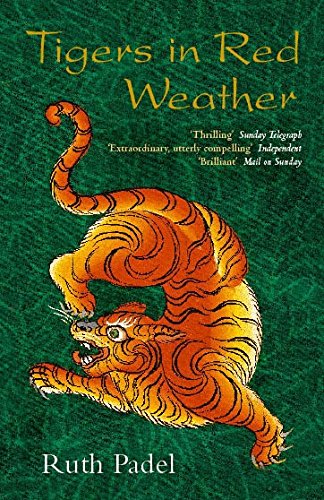
Ruth Padel
Tigers in Red Weather
‘An instant classic, beyond superlatives,’ Sunday Times of India
‘An extraordinary quest for the tiger in its forest home and in the human imagination. Padel is not a descendant of Charles Darwin for nothing. Her curiosity is daring and rigorous, her language eloquent. This is not only a superb portrait of Asian tiger country, but also of the fears and longings that the tiger creates in human hearts.’ Helen Dunmore
‘Occasionally you open a new book, read a few pages and just know, This is special,’ Washington Post
Read Ruth on “page 69″ in “Campaign for the American reader”
To research this book, published 2005, shortlisted in USA for the Kiriyama Prize and in UK for the W H Smith Prize, acclaimed by conservationists everywhere, Ruth travelled through tiger forests throughout Asia on foot, on elephants, in jeeps and boats.
Asia at the beginning of the twenty-first century, poised on the edge of change, as China’s shadow grows. A woman is exploring its threatened jungles for the animal they call ‘the soul of Asia’. Is this the tiger’s last moment before extinction? Who is trying to save it, and how? Are any wild tigers left? Where?
This is a book about loss and survival, poetry and science. About what you find when you enter the forest.
Among the cobras, bears, and golden langurs living tangled lives in the tiger’s shadow from Nepal to Siberia, Karnataka to Indonesia, with poems in her pocket to keep her going, Ruth Padel meets tigers, leopards, bee-keepers, forest guards, espionage teams pitted against ruthless poachers. Through secret remote Bhutan, the taiga of Far East Russia vulnerable to the mafia, jungles of Laos full of landmines, snowy forests of north-east China, and Sumatran rainforest with its illegal chainsaws, landslides, and tiger shamans, Ruth kayaks through rapids, camps on rain-forest mountains, and questions ‘defenders of the wild: the scientists, conservationists and forest guards struggling to protect the forest and its denizens from poachers and the mining and logging mafias that threaten the world’s last remaining wilderness.
What does wild mean? Why does it matter, that wilderness should continue, that wild tigers still exist? How do you deal with despair, faced with wildlife poaching and forest loss? What about the symbols and meanings we load the tiger with, which lead us both to revere and destroy it?
From reviews:
‘A work of moving originality and enchantment,’ Colin Thubron
‘A stunning plea for conservation and a stealthy excursion into the human heart,’ Oprah’s O Magazine
‘Lyrical, deeply impressive, gripping, informative, always intriguing and ometimes dazzling. There are few women writing non-fiction today with such a sophisticated understanding of language, nuanced approach to style, and willingness to engage with the big issues, personal and political. Only a poetic imagination could have whipped together disparate dollops of literature, science, autobiography and metaphysical musing to confect such a lyrical, deeply impressive book.’ Guardian
‘A beautiful book. Londoner Padel makes an unlikely tiger tracker but doesn’t let fear hold her back in remote, demanding places. She has the linguistic gifts and imaginative drive to keep the reader caring, explains the metaphysical as well as physical, scientific and political significance of the tiger.’ Sunday Times
‘Padel is best known as one of Britain’s most admired poets. With the ear of a playwright, she replicates speech patterns so deftly you can distinguish the differing English accents of her Chinese, Indian and Russian guides. She’s really terrific at this Even without the tiger lore, Padel’s adventures and misadventures while trekking, kayaking, climbing or riding an elephant, would make for a first-class travel book Indeed, the chapters on Bhutan and Ussuriland provide superb short introductions to these little-known parts of the world. But the tiger lore and tiger love remain at center stage’ Washington Post
‘Fine, illuminating writing: a model for any nature writer. Reminded me of Bruce Chatwin’s Songlines.’ Conservation Magazine, USA
‘Few books have said more about wildlife and human nature, and the relationship between the two, than Ruth Padel’s wonderful Tigers In Red Weather. The author is a poet who writes exquisite prose, and her book, which is both highly personal and generously objective, combines a vivid if elegiac passion for tigers, a strong sympathy for the people who live near them, and a lucid abhorrence for the greed and stupidity that are taking the animals to extinction,’ Spectator, UK
‘Essential reading for what man has done to the greatest of Nature’s creations. Padel’s tiger journey traverses every nook and cranny of the tiger’s world. Her observations about people who work with tigers are as crisp as those on the beasts. This is one of the finest pieces of tiger text I have ever read.’ Valmik Thapar, India Today
‘Brilliant.’ Calcutta Telegraph
‘A strange and powerful work, part-memoir, part-travelogue, part lovesong. Padel is brilliant at describing the various inhospitable terrains. Few writers do leeches, ticks and mosquitoes quite so well. When a tiger strays too close we feel its hot breath and see its glittering golden eyes as if we were there ourselves.’ Mail on Sunday
‘Illuminating this extraordinary travel-memoir is a Rimbaud-esque quest for the essence of ferocity. This is no mere gutsy travelogue but a poet’s attempt to do what the scientist does, ‘Say precisely what and how you saw’. This is the poet as super-naturalist, always giving more than her best, no-holds-barred, for that flash of the sublime.’ Independent
‘She is a poet with no previous history of plunging into snake-infested jungles and no special aptitude for it. She is neither big, fit, strong nor brave. But she is Darwin’s great great grand-daughter and a wonderful writer, and has produced the best book ever written on the places where tigers live. There is tiger meaning in all her landscapes – the Bhuddhist bells of Bhutan, ice winds of Tibet, dripping turquoise of the Bay of Bengal. Yet this is not a book of descriptions. At heart, it is about people and their relationship with animals.’ Evening Standard
‘Her poet’s eye brings the characters, two legs or four, to vivid life. And how however desperate her situation, she finds humour in it.’ Independent on Sunday
‘An outer journey of Asian expeditions, thrilling and surprising, matched by a restless inner journey, elegantly drawn. Her prose has an intense, lush quality to match the jungles. She has an adventurer’s intrepid spirit, a poet’s eye for detail, and an ear for dialogue.’ Telegraph
‘Tigers in Red Weather is a feast; in terms of adventure, a brow-sweating foray into the jaws of danger. It fulfils the requirement of great travel-writing: it surrounds you, engages the brain as well as the senses, and never slackens the momentum.’ The Scotsman
‘Wonderful, informative, fascinating: a learned and detailed study of tigers, their habits, their plight, their future. I love her detail. One sign of her brilliance – or should I say tigerishness – is that she keeps our attention all the way.’ Literary Review
‘Poems are scattered through the book like sunlight through trees. It begins with a beautiful description of tigers. Her poet’s eye is always evident; her images convey why saving any species matters.’ Scottish Herald
‘Full of intelligence… a book blessed with beauty and brains in equal measure, delightful and evocative.’ Christian Science Monitor, USA
‘A haunting document of our time: superbly evocative natural history, tiger myths and mysteries and the pressing moral debates around conservation.’ Metro, UK
